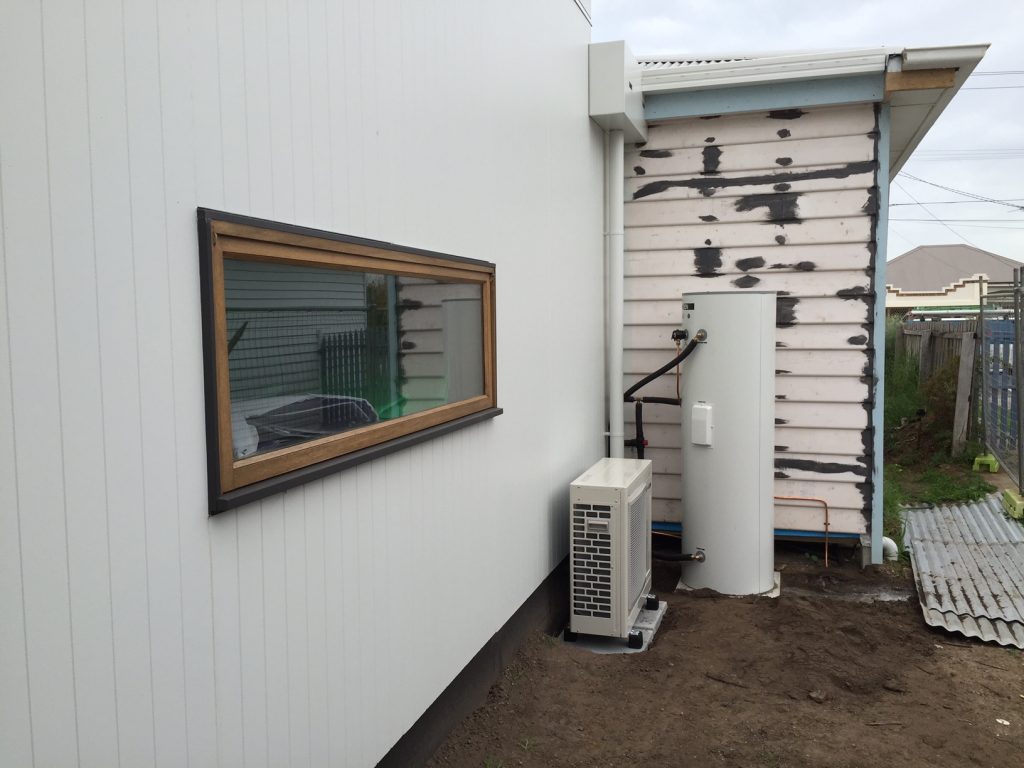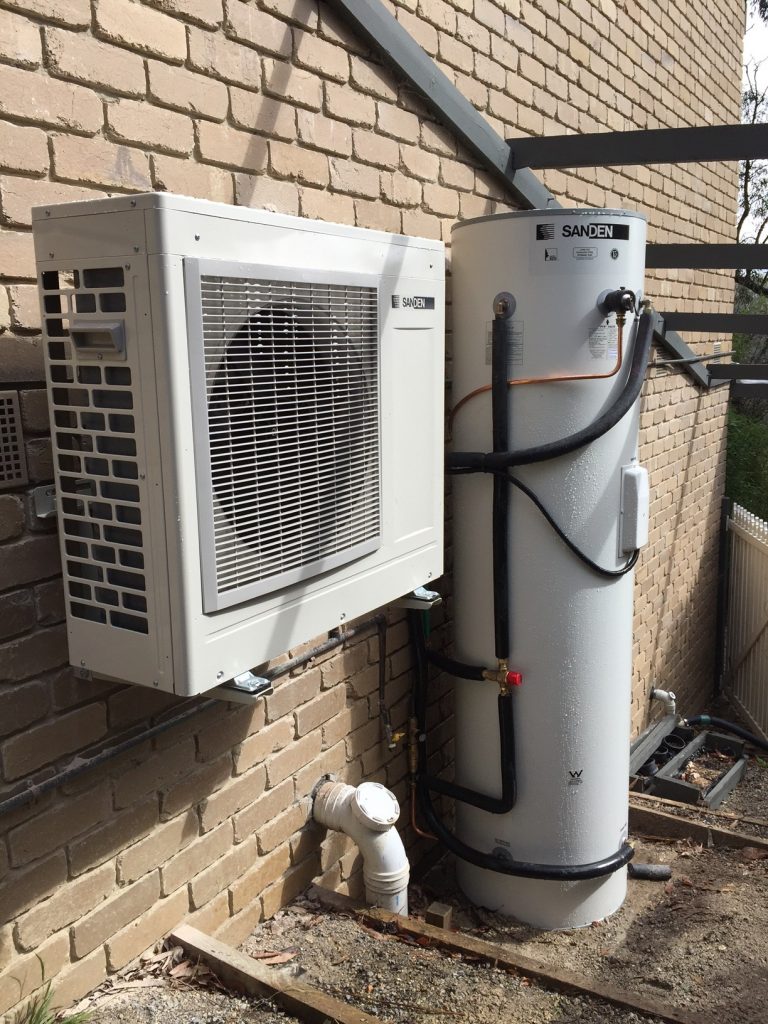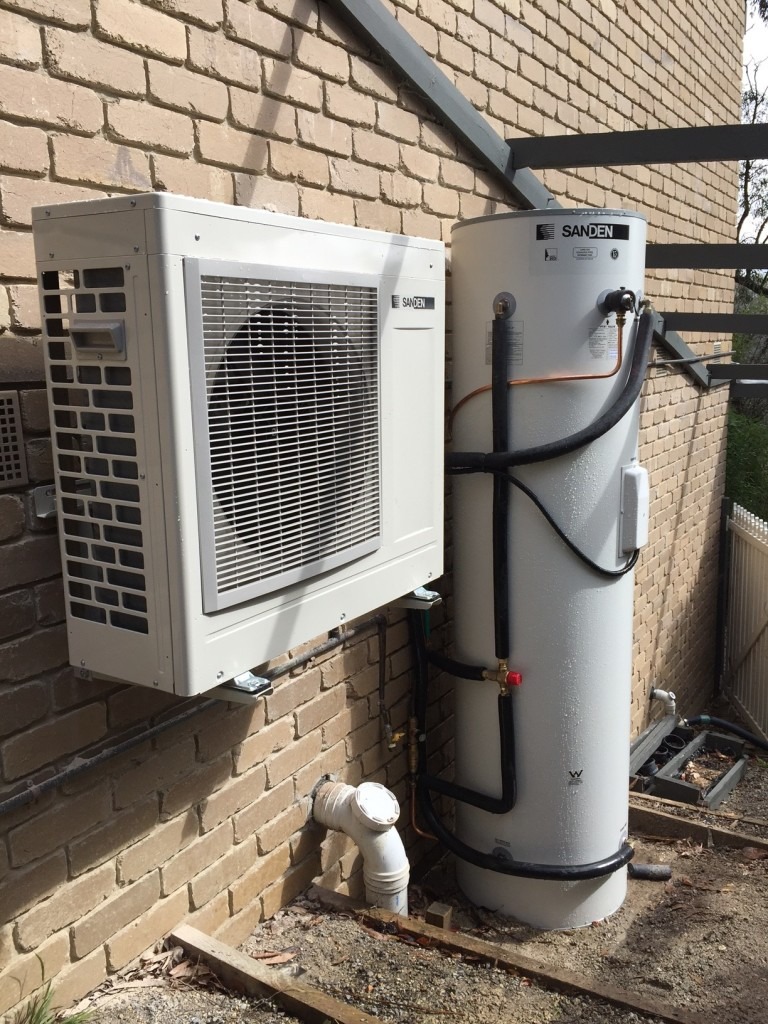
Maybe you’ve used a heat pump or at least heard of them. As with many unfamiliar concepts, the word “heat pump hot water system” may leave you scratching your head.
These cutting-edge heating methods are rapidly gaining popularity due to the substantial financial and ecological benefits they provide.
So, What Exactly Is a Hot Water Heat Pump System?
In comparison to conventional electric storage water heaters, heat pumps use just about 30% of the energy. They use renewable energy in the same way that solar panels do, by sucking heat from the air around them and using it to warm water.
Your home’s hot water energy usage can be cut by as much as 80% when you instal a heat pump hot-water system. The minimal amount of energy it needs can be supplied by solar panels at no additional expense. Hot water is the second largest energy consumer in the average Australian home, so this is a welcome save. When compared to other types of home hot water systems, heat pump systems produce the least amount of glasshouse gases.
How Does a System With a Heat Pump Work?
Like a reverse-cycle air conditioner, a heat pump can convert thermal energy into cooling. The water is heated, rather than the room.
Without further ado, let’s break down the basic operating principles of a heat pump:
- Systems that use a heat pump transfer warmth from the surrounding air to a storage tank of water.
- An evaporator, which is a set of fins, is cooled by the fan’s suction.
- The evaporator is where the air is cooled by a refrigerant that is circulating through the system.
- The vapourisation process increases both temperature and pressure, making the refrigerant more useful.
- When the steam passes through the heat exchanger, the water is heated while the refrigerant is cooled.
- After the vaporised refrigerant has released all of its heat, it condenses back into a liquid, and the process is repeated at the evaporator.
Heat pump systems, sometimes known as “air-source heat pumps,” function similarly to a refrigerator in reverse by drawing heat from the air around the water storage tank and transferring it inside.
Fundamentally, heat pump HWSs work by transferring heat from the surrounding air to an extremely cold liquid refrigerant that is circulated through the system via copper tubing. Compressing the liquid causes its temperature to rise because of the increase in pressure. The next step involves transferring the heat of the refrigerant to the liquid in the storage tank, which is accomplished by passing the liquid via a condenser. In the end, the pressure is lowered via the expansion valve, and the process begins again.
Various Heat Pump Configurations
Heat pumps can be installed in either a split system or an integrated system.
- A split system has a refrigerant piping system connecting the evaporator, fan, and compressor to the tank.
- The components of an integrated system (tank and compressor) are preassembled and sent together.
Based on the medium from which the heat is extracted, heat pumps are often divided into two broad categories: (ASHP) air-source heat pumps and hydronic heat pumps (WSHP).
While air source heat pumps (ASHPs) pull heat from the surrounding air, water source heat pumps (WSHPs) can draw heat from a variety of sources, including natural hot springs, waste hot water from factories, volcanic activity, and the earth itself.
While ASHPs are more affordable to instal and maintain than WSHPs, the latter are often more reliable and productive. Depending on the climate and the specifics of your land, one solution may be better than another.
The Origins of Heat Pumps
In 1852, Lord Kelvin, an Irish & Scottish scientist and engineer, discovered the first scientific model explaining the mechanism of heat pumps. He based his ideas on refrigeration science, which is counter to how heat pumps work. Finally, it was American innovator Robert C. Webber in 1948 who conceived and built the first fully functional ground-source heat pump.
When he burned his palm on the boiling water coming out of his electric deep freezer, he had an idea. In an effort to put this heat to good use, he channelled it via a conduit and dispersed it using a fan. In time, he perfected a full-scale system that utilised Freon as a refrigerant to heat his entire dwelling.
Is the Use of Heat Pumps for Heating Water Common in Australia?
The primary function of a heat pump system is to move heat from a cooler environment into a warmer one. The term “heat pump” refers to the device because of its primary purpose: moving heat from one location to another.

As opposed to air conditioners and refrigerators, whose primary purpose is to transfer heat from a cooler system to a warmer environment, this process is reversible.
It’s also reversible, so it can be set up to do double duty as a heater or air conditioner. These heat pumps may function in both directions, hence the name.
A “dedicated heat pump” is a heat pump that is only used for heating, as opposed to being reversible like an AC unit.
Heat pumps are commonly employed in area heating/cooling & hot-water system applications in Australia due to the country’s climatic diversity and the presence of all four seasons throughout most of the country.
Air conditioning, cooling drinkable water, heating indoor space, and heat pump hot-water systems for bathroom and kitchen usage are all viable applications in both private and public buildings.
About 3 per cent of the heating systems in use in Australia are heat pump water-heaters (HPWH).
Heat pumps have a wide variety of uses in industry, including but not limited to the aforementioned operations of cooling and heating, preheating boiler feed water, drying, pasteurising, and washing.
Heat pumps are useful because they can recycle the waste heat that is produced in factories. It is more cost-effective to put this heat to use in one of their processes than to let it escape into the atmosphere.
New Coolants for Heat Pumps
Compressible refrigerants are the lifeblood of heat pumps. They make it possible for heat to move from one part of the system to another.
Yet, they have been susceptible to modifications over the past forty years because of environmental worries, including ozone depletion and climate change.
Chlorofluorocarbons (CFCs) like R-12 and R-22 were the first commercially available refrigerants in the 1920s.
But, it was discovered in the 1970s that now the ozone layer on the planet has been diminishing, resulting in the surface of the planet receiving more intense UV radiation from the sun, which may cause global warming and many health problems.
This prompted the 1987 proclamation of the Montreal Protocol to restore the ozone layer. In part because of the chlorine in CFCs, one of the main causes of ozone depletion, it issued a mandate to eliminate their use.
During the 1990s, hydrofluorocarbons (HFCs) like R-134A, R-410A, and R-404A were developed as CFC substitutes.
However, it was later determined that the Global-Warming Potential (GWP) of HFCs is as high as 1,430, despite the fact that they did not contain chlorine and did not erode the ozone layer to the extent that CFCs did. That’s 1430 times more heat than carbon dioxide can capture in the atmosphere. Because of this, HFCs are also being reduced.
Heat Pump Water Heaters: Pros
A Decrease in Operating Expenses
The operating costs of heat pumps are typically lower than those of conventional heating methods for domestic hot water. As a result of its lower operating costs, you can anticipate annual savings of >$1600.
Simpler Upkeep
Less upkeep is needed for heat pumps compared to conventional hot water systems. It is recommended to have your heat pump inspected every 3–5 years by a competent installer.
Keeping Cool in the Summer
In their reverse setting, heat pumps function similarly to central air conditioners. Heat pumps that use air as their heat source can be simply converted to air conditioning.
Incredibly Prolonged Life Expectancy
A heat pump should last for more than 50 years. Nonetheless, 14–15 years has been the typical longevity.
Subsidy From the State
Incentives for renewable energy production have been provided by the government in the form of refunds (wind, solar and hydro).
Heat Pump Water Heaters: Cons
Costs a Lot More Money up Front
In comparison to other types of heating and cooling systems, heat pump installations are more expensive upfront. However, they will pay for themselves faster than conventional systems despite their higher operational expenses.
Troublesome to Set Up
A heat pump is not something that can be put in just any old place. Find the optimal environment for your system by conducting the necessary study.
Damage Caused by the Weather
Because of its inefficiency in frigid temperatures, heat pumps should not be utilised for an extended period of time outside of their intended climate.
Carbon-Neutrality Not Achieved
Unfortunately, heat pumps can never be totally carbon neutral since they still need power to function. The only exception would be if a solar-powered substitute were to be developed.
Funding From the Government Is Limited to the System
All that can be said with certainty is that the reimbursement will only go towards the price of the system itself and not the labour to set it up.
Requirements for Hot Water Heat Pump System Setup
A heat pump hot-water system is just as simple to set up as a conventional electric storage water heater. It is possible to have a heat pump if you have access to energy and a suitable location for the water heater. But this doesn’t imply you should automatically instal a heat pump HWS; make sure you live in a suitable climate.
Does the Location of a Heat Pump Matter?
Most heat pump systems are most efficient in areas where the average annual temperature is at least 19 degrees Celsius. While the compressors can still function in colder climates, they will have to work much harder, and they may not operate as long, driving up the price.
Heat pumps are very efficient, consuming just around one-third as much electricity as a conventional electric storage tank would. However, this claim needs to be verified by determining whether or not the storage tank system in question utilised off-peak electricity rates.
Heat pumps function on a demand basis.
Thus they will run during periods of high electricity prices if necessary.
If you use less electricity overall, you might not save money because of the higher prices of electricity during peak times. Your hot water expert and you should give some thought to how much it will cost to run the system.
In locations without access to natural gas and where solar thermal collectors are not practical, heat pump systems shine.
The Best Way to Pick a Hot Water Heat Pump

It may be more expensive up front than more conventional water heaters with a storage tank. They are worth the original expenditure due to their low operating costs.
Before investing in a heat pump system, you should think about the following:
- Need for a hot supply of water.
- Members in a family.
- How big your hot water tank is.
- Consider the system’s efficiency in terms of energy use.
- The expenses for upkeep and running each year.
Investing in a Heat Pump System: Yes or No?
Absolutely. You can reduce your monthly energy costs by using a heat pump. Installation is possible in places with a wide range of weather patterns.
With a heat source, they continue to function even in sub-zero temperatures. They assist you in lowering your carbon footprint and are more eco-friendly than electric hot water heaters.
Energy costs can be cut by as much as 80 percent when using a heat pump for hot water. When compared to conventional water heaters, heat pumps require roughly 30% less energy.
Their operation is analogous to that of solar panels in that they draw heat from the surrounding air and use it to preheat water.
In HWSs, the ambient air is used to cool a very cold liquid refrigerant. When liquid is compressed, the pressure increases, causing the temperature of the liquid to rise.
Natural hot springs and waste hot water from factories are just two of the many places from which water source heat pumps (WSHPs) can draw heat.
One way to move heat from one location to another is with a heat pump. As early as 1852, Lord Kelvin developed the first scientific model of the heat pump’s workings.
In 1948, American innovator Robert C. Webber conceived of and constructed the first fully functional ground-source heat pump. It is common practise to use heat pumps for local heating, cooling, and hot water supply.
Heat pump water-heaters account for about 3% of Australia’s residential heating systems. The cooling and heating capacities of heat pumps are only two of their many applications in industry.
Heat pumps for domestic hot water typically have lower operating costs than other common heating methods. Heat pumps have a longer life than other heating and cooling systems and only require minimal maintenance over the course of their 14–15 year average lifespan.
